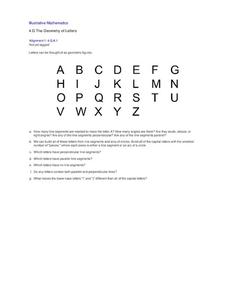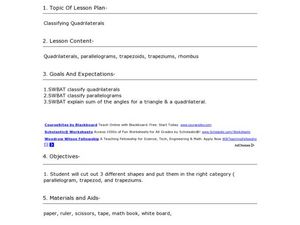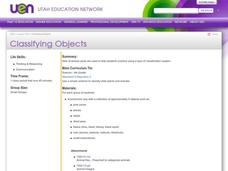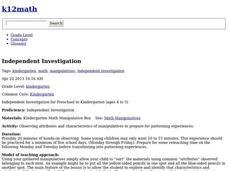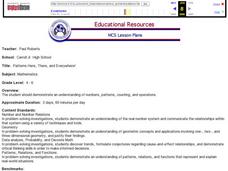Curated OER
Classifying Objects into Group
Classifying and sorting are great skills all kids need to know. They cut out each of the six images provided, then label each of two boxes. They glue the images in the appropriate box. Answers are provided.
Illustrative Mathematics
The Geometry of Letters
Use the alphabet as a tool for teaching your class about geometric figures. Break apart capital letters into line segments and arcs. Classify angles as right, acute, or obtuse. Identify parallel and perpendicular lines. An excellent...
Curated OER
Teaching and Learning Through Objects
Students identify and interpret the function, usefulness or utitlity, form, beauty or aesthetics, and meaning, context or story, of objects and how they learn new skills and make things that they learn traditionally, by observation and...
Curated OER
Classifying Lesson Plan
Students classify objects according to their similar characteristics.
Curated OER
Classifying Toys
In this classification worksheet, students cut out 47 small pictures of toys. They classify the pictures in groups of their choosing. They tell the reasons for grouping the items the way they did.
PBS
Button, Button
Youngsters count, classify, and estimate quantities using buttons after a read aloud of The Button Box by Margarette S. Reid. They discuss the difference between guessing and estimating. Based on an experiment, they predict the...
Illustrative Mathematics
3-D Shape Sort
From the apple on your desk and the coffee cup in your hand, to the cabinets along the classroom wall, basic three-dimensional shapes are found everywhere in the world around us. Introduce young mathematicians to the these common figures...
Curated OER
Sorting and Classifying Concrete Objects by Varying Attributes
First graders examine how to sort concrete objects by their attributes. In this sorting lesson plan, 1st graders listen to Gray Rabbit's Odd One Out by Alan Baker, and discuss the actions of the main character. They practice sorting...
Curated OER
Classifying Quadrilaterals
Fourth and fifth graders learn to classify quadrilaterals and use more than one name for each. They follow the directions and classify three quadrilaterals. There are also activities which can be done with a partner.
Curated OER
Sorting and Classifying
Students explore organization by participating in an object sorting activity. In this classification lesson, students view a diagram which details the different ways to sort items. Students practice sorting random objects in class by...
Balanced Assessment
Bumpy-Ness
Develop a new measure of the properties of an object. Scholars develop a definition and formula to measure the bumpy-ness of an object. They utilize their formulas to find the property for several spherical objects.
Curated OER
Classifying Objects
Fourth graders work in small groups to sort and classify a variety of objects. They develop criteria for sorting and explain the characteristics they chose for classification. Groups record and share their classifications.
Curated OER
The Grouchy Ladybug
Students learn about sorting and classifying objects by size while reading Eric Carle's "The Grouchy Ladybug". In this sorting and classifying lesson, students first listen to and interact with the story. They then look at cut-outs of...
Curated OER
Classifying Toys
In this classifying worksheet, students cut out fifty seven squares, each containing a different picture of a toy. Students classify the pictures of toys into groups of their own choosing (uses, material they are made of, who plays with...
Curated OER
Classification And Identification
Students explore diagrammatic and taxonomic keys and their application in the marine sciences. They sort and classify objects and organisms based on visual attributes.
Curated OER
Sorting and Classifying Outdoors
Students use their math skills of sorting and classifying with materials they collect outdoors. In this early childhood math lesson, students participate in a treasure hunt to gather item in nature and categorize their finds.
Curated OER
Independent Investigation
Young scholars classify objects. In this math lesson plan, students sort and classify objects based on their characteristics. Young scholars identify characteristics of objects.
Curated OER
Sorting Objects
Students sort objects by color. In this classification instructional activity, students identify the color of the objects and categorize them according to color.
Pennsylvania Department of Education
Exploring Likenesses and Differences of Objects
Students explore how to use similarities and differences when sorting objects. In this exploring likenesses and differences of objects lesson, students examine ways to classify objects. Students make connections and classify objects...
Curated OER
Classification
Students investigate how different types of food can be classified then counted. For this sorting, arranging, and classifying lesson plan, students explore how to group foods based on commonalities. Students are asked four questions...
Curated OER
Measurement: The Size is Right
Specific learning goals are grouped for different grade levels spanning pre-kindergarten to eighth grade. After preparing the questions and materials, you call a learner to come in front of the class and play the game. Young learners...
Curated OER
Patterns Here, There and Everywhere
Pattern recognition is a skill often used in mathematics. Learners count and sort manipulatives, organize the data into a graph and answer questions about the information displayed. They collect the objects to be used and create patterns...
Curated OER
Fun With Sorting and Classifying
Using a variety of activities, kindergartners explore sorting and classification. Learners engage in an online sorting activity, read books involving classification, and create their own class book. This is a marvelousway to explore this...
CK-12 Foundation
Venn Diagrams: T-Shirt Mystery
Sorting your t-shirts is easy with Venn diagrams. Individuals use a drag and drop interactive to classify shapes on t-shirts into Venn diagrams. A set of challenge questions tests whether the classification is correct.

